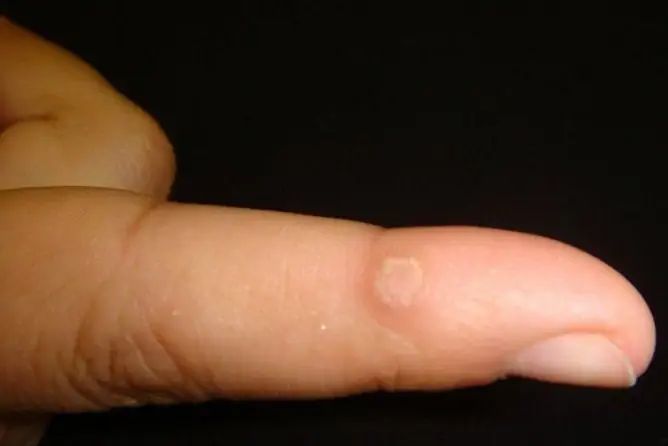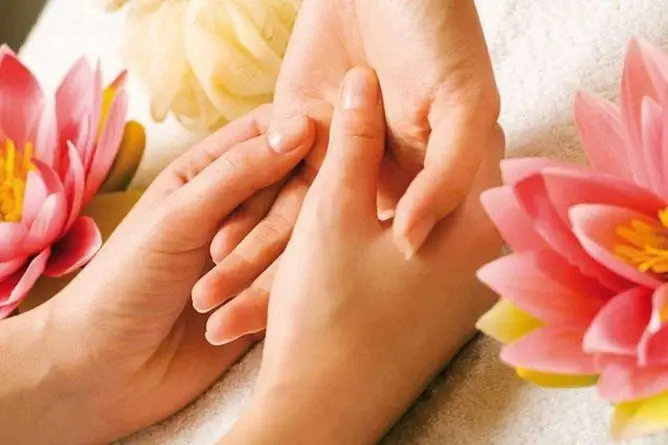- Author Rachel Wainwright [email protected].
- Public 2024-01-15 19:51.
- Last modified 2025-11-02 20:14.
A bruised finger on the hand: first aid, what to do at home
The content of the article:
- Symptoms
- Diagnostics
- First aid for a bruised finger
-
How to treat a bruised toe
- Drug therapy
- Fixation
- Physiotherapy and physiotherapy
- Traditional methods of treatment
- Recovery period
- Video
A bruise of a finger on a hand is one of the most common closed traumatic soft tissue injuries in traumatology. Usually it occurs due to domestic reasons - direct impact, falling heavy objects, pinching, etc.

A bruise of a finger on the hand most often occurs for everyday reasons
Its main manifestations are cyanosis, swelling, limitation of movement and sharp pain. If the blow fell on the nail phalanx, a subungual hematoma may occur against the background of a bruise.
Since the clinical signs of such injuries are in many ways similar to the symptoms of bone fractures or injuries of the interphalangeal joints, it is recommended to seek the help of a traumatologist. If there is a suspicion of a fracture of the injured person, the doctor will send it to an X-ray and, according to its data, will make an accurate diagnosis.
Therapy for bruises is conservative, it includes the use of drugs and physiotherapy. In cases of detection of a large subungual hematoma, an autopsy is performed.
It should be borne in mind that if the nail phalanx is severely bruised, the extensor tendon may tear or tear from the attachment site. Only with an early visit to a traumatologist and the identification of such a consequence of trauma can surgical intervention be avoided, while with a late start of treatment, it is much more difficult to do without surgery and the development of complications.
Symptoms
The first thing that patients complain about after a bruise is soreness of soft tissues in the area of impact. The injured finger, due to damage to the vessels and the release of the liquid part of the blood into the intercellular space, begins to swell, and due to the soaking of soft tissues with blood, it first acquires a red, then a purple, blue or purple hue.

Subungual hematomas are painful
Another manifestation of such an injury is pulsation at the site of injury.
In the thickness of the skin, as well as under the nail bed, hematomas can be detected. In this case, due to the formed high pressure zone, subungual hematomas are noted as the most painful, accompanied by twitching and bursting of the affected area.
The severity of bruising symptoms varies depending on the severity:
| The severity of the injury | Symptoms |
| Easy | The pain syndrome is weak, and the swelling and redness of the skin is minor |
| Average | The pain syndrome is more pronounced, the edema can spread to nearby tissues. The skin can take on an intense red, even purple hue. Functionality is not broken |
| Strong | Severe contusion of a finger on the hand is manifested by intense pain syndrome, significant edema, hematoma and dysfunction |
In many ways, the manifestations of bruises are similar to those in fractures, therefore, a traumatologist should diagnose and select treatment, especially in severe cases.
Diagnostics
When the victim enters the trauma center, an external examination of the injury site is carried out. Usually, when feeling a finger, patients complain of increased pain, some limitation of movements is found.

To clarify the diagnosis, you may need to consult a traumatologist
Unlike a fracture, there are no pathological mobility, bone crunch, abnormalities in anatomical relationships or gross deformity with bruises. However, for the exact exclusion of a fracture, with a moderate and severe degree of damage, the victim is sent for X-ray.
For injuries in young children, computed tomography of the hand may be prescribed, during which you can get a photo of all fingers - from the little finger to the thumb. The diagnosis of contusion is confirmed if, according to various studies, no pathological changes in the bone structures are found.

If a fracture is suspected, an x-ray of the hand is prescribed
When hitting the end part, as well as in cases of falling on a straightened finger in the area of the nail phalanx, along with a bruise, a complete or incomplete subcutaneous rupture of the extensor tendon can be detected. In case of incomplete rupture, the movements of the finger are partially preserved, but its full extension is impossible.
First aid for a bruised finger
First of all, immediately after the impact, the ring, if any, should be removed from the injured finger, since it will be difficult to do this later as the edema grows. The injured finger should be kept under running cold water or ice should be applied to it.

To reduce pain, cold should be applied to the site of injury immediately after injury.
It is important to bear in mind that cold compresses can only be used to relieve acute pain for a short time, since prolonged exposure to water can negatively affect the condition of the skin. It is most effective to use an ice pack to prevent severe edema, reduce hemorrhage and vasoconstriction.
For minor abrasions or wounds, you can gently anoint them with brilliant green or iodine. In cases of partial nail detachment, the wound should be washed with an antiseptic and covered with a sterile bandage to avoid further trauma.
After providing first aid, the victim should seek help from the trauma center to exclude a fracture or dislocation and receive a scheme for further treatment of the injury.
How to treat a bruised toe
Therapy for bruises of the fingers of the upper extremities is carried out on an outpatient basis, hospitalization in such cases is not required. If the patient has intradermal hematomas, they are cured by dissection. Small subungual formations are punctured with a sterile needle, thereby releasing the accumulated blood in them. Large hematomas may be an indication for removal of the nail plate.
The injured hand is fixed in an elevated position and cold compresses are applied to it, which are subsequently replaced with dry heat (compresses with magnesia, cotton bandages, bags of heated sand). Thanks to heat, blood circulation improves, regeneration processes are activated, and the restoration of damaged tissues is accelerated.
Drug therapy
Pain relief for bruises is usually not required, but if the pain is intense, a single dose of an analgesic (Ketorolac, Analgin and others) may be prescribed.
In the presence of deep wounds, the doctor may prescribe anti-inflammatory ointments (Indomethacin, Diclofenac). They should be applied in a thin layer over the damaged area.
Fixation
In cases of subcutaneous rupture of the extensor tendon, a special bandage or plaster splint is applied to the injured finger. These devices allow you to fix the finger in a straightened position in a state of overextension.

In some cases, fixation of the bruised toe is required
In some cases, immobilization of the finger may be required while maintaining the middle phalanx in a bent position, and the nail in a straightened state. Most often, the time of such immobilization is 28 days, after which a re-examination is carried out.
If the victim is unable to actively extend the finger, a tendon suture is performed, followed by fixation with a plaster splint or Kirschner wire.
Physiotherapy and physiotherapy
For severe injuries, the doctor may recommend physical therapy and physiotherapy to improve the mobility of the injured limb, its blood circulation and nutrition, as well as restore soft tissues.
From the methods of physiotherapy, magnetotherapy, ultrasound and electrophoresis with anti-inflammatory drugs are used. The first two methods allow accelerating the restoration of soft tissues, and thanks to electrophoresis, the accumulation of anti-inflammatory drugs in damaged tissues is achieved.
Traditional methods of treatment
As additional methods to conservative treatment, traditional medicine recipes can be used, but only as directed by a doctor. The most effective remedies for bruises are:
- recipe number 1: mix rye flour and honey in equal proportions. The resulting cake is applied to the injured area and fixed with an elastic bandage at night;
- recipe number 2: medical alcohol or vodka is mixed with water in a 1: 1 ratio, a cotton swab is moistened in the resulting solution. Lotions are performed 3-4 times a day for 2-3 days.
Folk remedies for the treatment of bruises should be applied no earlier than 2-3 days after the injury.
Recovery period
On average, recovery of the fingers of the upper limb after injury lasts from 14 to 21 days, depending on the severity of manifestations. Painful sensations can be noted for a longer period, and if the nail plate has suffered during the impact, its full regrowth takes several months.
During the recovery period, you should avoid any stress and limit the movement of the injured limb. It is important to follow the recommendations of the traumatologist regarding the use of special fixators, as well as the dosage and duration of drug use.
Video
We offer for viewing a video on the topic of the article.

Anna Kozlova Medical journalist About the author
Education: Rostov State Medical University, specialty "General Medicine".
Found a mistake in the text? Select it and press Ctrl + Enter.






